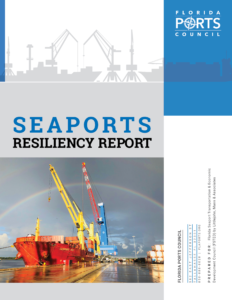News & Updates
Florida seaports prepare for hurricane season

While most of us are still fully focused on the effects of the global pandemic, Florida’s seaports are juggling another potential threat – the 2020 hurricane season. However, Florida’s 15 seaports are well-versed in this type of emergency and they lead the nation in natural disaster resiliency according to the Seaports Resiliency Report, released by the Florida Ports Council last fall.
 The report provides recommendations for all ports across the state to be prepared for future environmental changes and disruptive events.
The report provides recommendations for all ports across the state to be prepared for future environmental changes and disruptive events.
Florida’s ports support more than 900,000 jobs across the state, and have a total economic impact of more than $117 billion. Disruption of local ports causes major economic and recovery challenges. Port resiliency, which allows continued freight movement after a crisis, includes planning for damage to infrastructure, a lack of fuel, a shortage of workforce and a lack of communication and technology.
Seaports are required to address environmental issues, including sea level rise and upgrades to infrastructure for resiliency, through their master planning process. Florida’s seaports also have an innovative Memorandum of Understanding to assist impacted ports with resources after an event and have invested in a single information reporting software, ARES CommandBridge, to connect and share information together, as well as with state and federal agencies, before, during and after a critical incident.
The report also provided recommendations for port resiliency, including:
- Conduct regular simulations or scenarios of critical incidents to improve response.
- Ensure access to generators and fuel for generators stored at heights above storm surge areas.
- Backup all technology and communications systems in the cloud and off-site to gain access to critical documentation.
- Have agreements in place to secure water, shower and toilet providers in advance of an incident. Also have bedding supplies and access to food and water for employees.
- Procure and test satellite phones or two-way radios for a backup form of communication should cell towers fail.
- Move truck, rail and other cargo to temporary safe locations, if possible, before an event.
- Have a plan in place for a labor shortage to handle disruptions in cargo movement.
- Work with tenants to review resiliency or continuity of operations plans for businesses on port property to coordinate response and recovery.
Best Practice: PTB Hosts Annual Hurricane Preparedness Tabletop Exercise
Port Tampa Bay hosted its 8th annual Hurricane Preparedness Tabletop Exercise on May 27th. This is one of many choreographed exercises to best prepare all Tampa Bay area agencies for all possible hurricane and/or tropical storm scenarios. As we well know, Hurricane Irma targeted the Tampa area two years ago, prompting significant challenges. Port Tampa Bay continued to operate at its highest level, providing fuel to the state of Florida and beyond. Port Tampa Bay, in its constant effort to improve its response, holds this drill every year.
Each year, the Hurricane Preparedness Tabletop Exercise is held with the National Weather Service to refine and improve Port Tampa Bay’s response to a storm. The Port invites several external partners including the United States Coast Guard; Customs, Border and Protection; Hillsborough Sheriff’s Office; CSX Railroad; various tug companies; and port tenants, among others. The meeting is open to the public and designed to help several emergency response agencies talk through a response to a severe storm. Read More …..
Important links to know before and after a natural disaster:
- Florida Business Disaster Planning Toolkit
- Business Planning Disaster Toolkit (all states)
- Florida Emergency Management Latest News Updates
- Florida 511-Traffic Updates & Road Closures
- Florida Department of Economic Opportunity- Long Term Recovery Resources
- Volunteer Florida– Disaster Fund and Job Opportunities
- Division of Consumer Services
